A Brook in the Heart of Zagreb - Along the Medveščak Brook from source to mouth
Exhibition concept: Nada Premerl
Exhibition design: Željko Kovačić
Poster design: Miljenko Gregl
 This exhibition shows through, some dozen units, the life and urban development along the Medveščak Brook, from its source alongside Kraljičin zdenac (Queen's Well) to its confluence with the Sava River, and highlights all the important features of life along this stretch, taking in the urban and the economic, entertainment and everyday life.
This exhibition shows through, some dozen units, the life and urban development along the Medveščak Brook, from its source alongside Kraljičin zdenac (Queen's Well) to its confluence with the Sava River, and highlights all the important features of life along this stretch, taking in the urban and the economic, entertainment and everyday life.
The ploughed fields and pastures in the Sava plain below the fortified twin city are cut across with numerous irrepressible brooks and streams that rush down from Mt Medvednica, the water of which made an essential contribution to the basic existence of the medieval town. Certainly the most important of all these was the brook Cirkvenitza (later called Medveščak), the artery flowing between the two neighbouring settlements and the centuries-old border between Kaptol of the bishops and chapter, and the Free and Royal burgh of Gradec. The Cirkvenitza was first mentioned in a document of King Emerik, of 1201, in which the borders of Kaptol are confirmed. It is also mentioned by King Bela IV in his Golden Bull and by Matthew Corvin in later certificates.
In the Middle Ages it is also called Matičina, and a tributary of it, actually an artificial millrace excavated in the mid-13th century from Okrugljak to Krvavi most, is called Pretoka or Prekopa. In the 19th century it was also called Melinski [Mill] Stream; this flowed in parallel with the Medveščak from Okrugljak to Vogel's Mill at today's Zvijezda, along the western side of it; further on it crossed the main stream from the east, and somewhere in the middle of today's Medvedgradska Street, at the site of the Croatian Academy's Glyptotheque, once again crossed to the west of the Medveščak Brook, going on along today's Kožarska Street to Krvavi most, below which it flowed into the Medveščak Brook.
 Until the end of the 19th century, the Medveščak Brook flowed through the whole of the town: along the Ksaver valley, today's Mevedgradska and Tkalčićeva streets, Pod zidom, crossing Bakačeva Street, going on across the old fair Ground, or Sajmište, and then suddenly swerved south-eastwards, flowing into the Sava River at today's Žitnjak.
Until the end of the 19th century, the Medveščak Brook flowed through the whole of the town: along the Ksaver valley, today's Mevedgradska and Tkalčićeva streets, Pod zidom, crossing Bakačeva Street, going on across the old fair Ground, or Sajmište, and then suddenly swerved south-eastwards, flowing into the Sava River at today's Žitnjak.
For centuries, its waters drove the mills of the town, of the dean and chapter, the Cistercians, the parish and the tradesmen. On the layout model, along with other importanf items of information, all 25 Zagreb mills are marked in.
From the 13th century the Cathedral's and municipal bathing and curative spots were here. People bathed in heated Medveščak water, prepared by the bathhouse attendants or balneators. Here there was blood-letting and horns, as they were called, were applied; the barbers were also surgeons, and they extracted teeth, salved wounds, shaved the citizens and cut their hair and other things. In 1291 the Cistercians kept the first public baths below St Mary's Church. At the beginning of the 19th century in today's Kožarska and Medvedgradska streets and in Nova Ves, municipal steam baths were built, which turned into places of entertainment. One of the best known bagnios, Petrova kupelj (today Medvedgradska 15, 17) was rebuilt in 1898 for a so-called licensed establishment. Mrs Rose Aranjoš, that is, applied to the City Fathers to transfer “her concession for girls' business because of shift in the course of the Medveščak Brook” from Kožarska no. 8 to no. 69. Mayor Adolf Mošinski authorised this building, in spite of many petitions and signatures of citizens against having a whorehouse in their neighbourhood.
Particularly well advertised was the “fashionable” wooden bathing place and cold water cure called Mrzlice on the estate of entrepreneur Josip Franjo Rempfel at St Ksaver (Xavier), below the church, on the later Mallin estate. It was opened on June 1, 1844, and the physician Josip Schweigert treated his patients with a new method – hydrotherapy. The papers advertised rooms to let, a restaurant, paths laid out for walks, everything in fact for the pleasure and comfort of the patients.
The Medveščak Valley is certainly one of the most beautiful of those created across the foothills of Mt Medvednica by the numerous little brooks. The interweaving of various features in the past makes it rather special The exhibition draws particular attention to this diversity as well as to the water, the real source of life there. Trades, commerce, the beginnings of manufactures and industry, and the lifestyles and residences of various social classes make this suburb and its northern country-house and economic part very particular. The tradesmen, the artisans, and petit bourgeois burgher mentality are sociological characteristics of the lower, plains, actually the residential part of the valley.
Here the first Zagreb manufactures came into being, that of the clothier Franjo Kušević, by the Church of St Xavier (1750), one of the biggest textile manufactories in northern Croatia of the time. The Kaptol paper manufactory in Nova Ves is one of the oldest, was a flour mill turned into a rag mill, and there are even tinted drawings of a paper works of the end of the 18th century. The work stopped about 1825, and the same mill was used for grinding clay in the manufacture of earthenware. Particularly attractive are the some original items from the oldest Zagreb manufactories, from Barbot's earthenware to a workshop for the Faber's manufacture of files in Potok street, no. 74.
Along the millrace (around today's Kožarska Street no. 48) the oldest Zagreb liquor manufacturer, Rosoglio, owned by Jakob Weiss was in operation up to 1811. The tradition of tanning along the brook led to the construction of the Leather Factory (1869), which expanded to become a major industrial site in Zagreb. In the last sixty years, the Croatian Academy's sculpture museum, the Glyptotheque, has occupied the building.
The torrential Medveščak Brook gave the citizenry a great deal of anxiety. In 1651, catastrophic floods were recorded for the first time. The water carried rocks, bore trees and razed houses down to the ground. Since the disaster happened after a storm at night, the water took 52 lives as well. Canon Baltazar Adam Krčelić gives a vivid description of the flood of 1750 when the brook gouged a new course for itself at Harmica and destroyed many a house in the process.
The daily newspapers recorded floods every year. January 5, 1846 was catastrophic and unusual, when after “a terrible Siberian winter a sirocco suddenly blew up”. The snow melted so suddenly that the Medveščak burst its banks, flooded Harmica and the neighbouring streets, along which the torrent rolled to the Sava River. The following day on Harmica, say the chroniclers, there was a mass of icebergs that the tempestuous brook had carried down.
 With good reason, right up to the mid-18th century, on the banks only mills were built, together with modest, wooden burgher houses with thatched or shingled roofs. The first masonry houses came after the cessation of threats from the Ottomans, in the mid-17th century, on the left bank. When the Baroque Church of St Mary was built in the mid-18th century, particularly when the two-flight staircase was put up along the western façade, through which it descended directly towards its parishioners, systematic construction of the centre of the settlement started Na potoku, on the brook. The most important buildings were put up next to the church on the eastern side of the street. Characteristic decorative elements of provincial Baroque give these craftsmen's two-storey houses the character of a very particular petit-bourgeois architecture. Big portals led
With good reason, right up to the mid-18th century, on the banks only mills were built, together with modest, wooden burgher houses with thatched or shingled roofs. The first masonry houses came after the cessation of threats from the Ottomans, in the mid-17th century, on the left bank. When the Baroque Church of St Mary was built in the mid-18th century, particularly when the two-flight staircase was put up along the western façade, through which it descended directly towards its parishioners, systematic construction of the centre of the settlement started Na potoku, on the brook. The most important buildings were put up next to the church on the eastern side of the street. Characteristic decorative elements of provincial Baroque give these craftsmen's two-storey houses the character of a very particular petit-bourgeois architecture. Big portals led
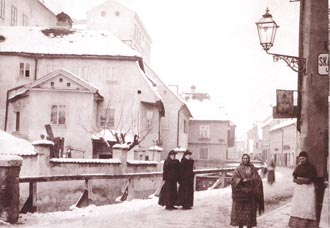 into yards with long courtyard wings, open with wooden or glazed ganjčeces, sometimes too with masonry-built arcades and balustrades that were inspired by the architecture of the upper town. The houses on the western, right bank, on the narrow plots between the brook and the millrace, had their longer façades towards the street, because the area available did not allow them to stretch down into the site. Directly onto the stream, without any courtyards, they turned their characteristic wooden gallery or corridor, the ganjčec, to the street, thus creating another type of artisan's house typical of Potok street.The houses were entered via the numerous little bridges or from Kožarska Street. The exhibition draws particular attention to the importance of Tkalčićeva Street, and its sociological and urban structure. This street is a symbol of the one-time brook, and a symbol of the Zagreb burgher or purger identity.
into yards with long courtyard wings, open with wooden or glazed ganjčeces, sometimes too with masonry-built arcades and balustrades that were inspired by the architecture of the upper town. The houses on the western, right bank, on the narrow plots between the brook and the millrace, had their longer façades towards the street, because the area available did not allow them to stretch down into the site. Directly onto the stream, without any courtyards, they turned their characteristic wooden gallery or corridor, the ganjčec, to the street, thus creating another type of artisan's house typical of Potok street.The houses were entered via the numerous little bridges or from Kožarska Street. The exhibition draws particular attention to the importance of Tkalčićeva Street, and its sociological and urban structure. This street is a symbol of the one-time brook, and a symbol of the Zagreb burgher or purger identity.
We have shown the home décor in the modest artisan houses with a reconstructed hiža, or northern Croatian style cottage, according to the last will and testament of boot-maker Mihalj Bogady, of 1780, and photographs of characteristic interiors.
 One of the central sections of the exhibition is devoted to the miller and the millers' guild, as being particularly important in the economy. Along with the 25 mills along the Medveščak, just in the first half of the 19th century, more than 100 master millers, all members of the guild, were registered in Zagreb in the first half of the 19th century alone. Here grain for the use of Zagreb was ground before the founding of the steam powered mill (1862).
One of the central sections of the exhibition is devoted to the miller and the millers' guild, as being particularly important in the economy. Along with the 25 mills along the Medveščak, just in the first half of the 19th century, more than 100 master millers, all members of the guild, were registered in Zagreb in the first half of the 19th century alone. Here grain for the use of Zagreb was ground before the founding of the steam powered mill (1862).
They were on the whole torn down at the end of the 19th century, when the borough bought them up for the sake of diverting the Medveščak, and yet some of the Mills on Ksaver Road worked up to the middle of the 20th century. So that their locations should not be forgotten, we have reconstructed them and placed them on the layout model placed on the floor of the exhibition room.
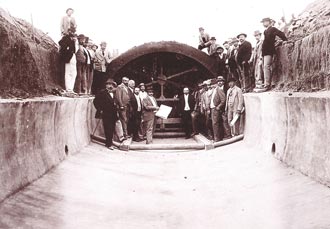 The original plans and photographs of the engineering of the brook and its culverting at the end of the 19th century show an important municipal programme, the beginning of the system of municipal sewerage, which the city authorities (the Magistracy) had been considering since the end of the 18th century. As well as being a source of propulsion for many business facilities, the brook also had a great ecological importance, particularly in the sultry Zagreb summers. Since at that time, as it is today sometimes, the ecological awareness of the citizenry was not at a very high level, the brook became, however, a den of stink and of danger from floods. Along with the regular floods, repairs of bridges and houses, quarrels among the millers, it was a major problem to the city fathers. At the end of the 19th century, industry had upset the ecological balance of the brook. All these problems led to the brook being diverted into a new culvert, so that the planning of a modern Zagreb could be addressed. In many authentic photographs we shall track the changing of the course of the Medveščak into its new eastern course, from Gubec's Zvijezda, via Medveščak Street, along which it flowed in an open if engineered bed as far as today's Niko Gršković's Street, when the Zagreb Electric Tram company culverted it at its own expense, so as to be able to complete the tram line along Ribnjak and Medveščak in 1931.
The original plans and photographs of the engineering of the brook and its culverting at the end of the 19th century show an important municipal programme, the beginning of the system of municipal sewerage, which the city authorities (the Magistracy) had been considering since the end of the 18th century. As well as being a source of propulsion for many business facilities, the brook also had a great ecological importance, particularly in the sultry Zagreb summers. Since at that time, as it is today sometimes, the ecological awareness of the citizenry was not at a very high level, the brook became, however, a den of stink and of danger from floods. Along with the regular floods, repairs of bridges and houses, quarrels among the millers, it was a major problem to the city fathers. At the end of the 19th century, industry had upset the ecological balance of the brook. All these problems led to the brook being diverted into a new culvert, so that the planning of a modern Zagreb could be addressed. In many authentic photographs we shall track the changing of the course of the Medveščak into its new eastern course, from Gubec's Zvijezda, via Medveščak Street, along which it flowed in an open if engineered bed as far as today's Niko Gršković's Street, when the Zagreb Electric Tram company culverted it at its own expense, so as to be able to complete the tram line along Ribnjak and Medveščak in 1931.
 Immediately after Medveščak Brook was diverted came the new town plan, mostly worked out by Milan Lenuci on behalf of the City Architect's Office.
Immediately after Medveščak Brook was diverted came the new town plan, mostly worked out by Milan Lenuci on behalf of the City Architect's Office.
The exhibition ends with the unit Medveščak Brook Today. Using the recently taken documentary photographs of Goran Vranić, which follow the course of the brook from its spring to the place where it flows into the city sewage system in Mihaljevac, we show what the torrential brook stands for today in the context of the Medvednica Nature Park. It still flows along its natural course with many rapids and falls from its source to the dam by Lagvić, then continuing by an engineered but open concrete bed as far as Mihaljevac, plunging down into the culverted channel below Ksaver Road, Medveščak and Ribnjak, then along Draškovićeva to Držićeva, where it links up with the main drainage channel, and has its final outfall in the Sava by Ivanja Reka.
Nada Premerl
Pictures from the exhibition
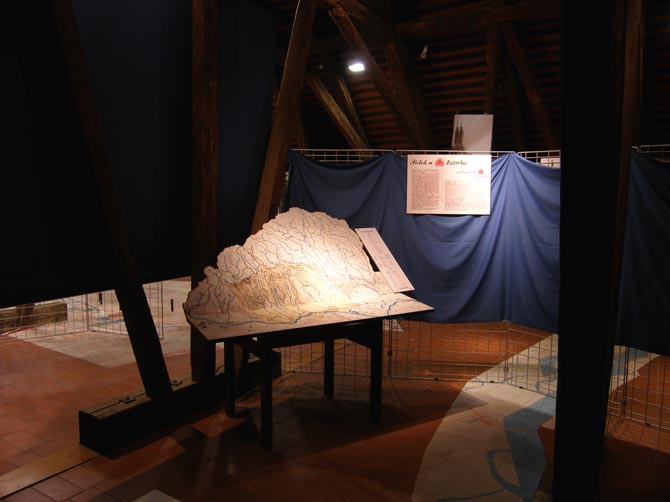


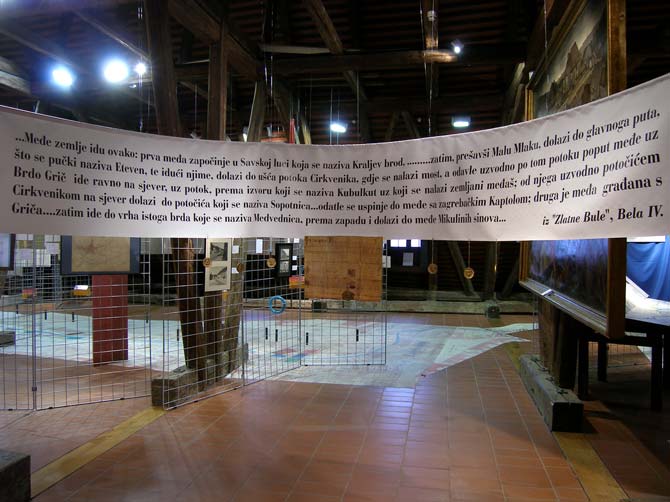

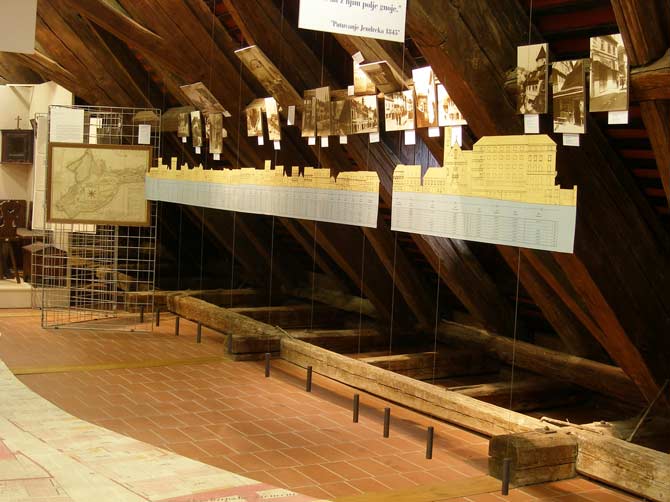
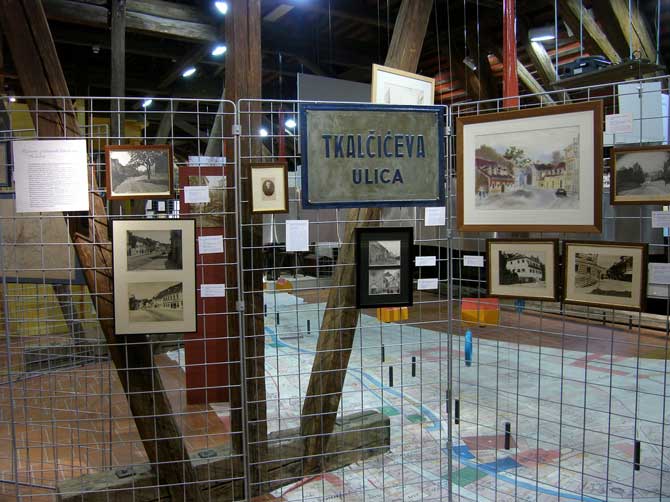
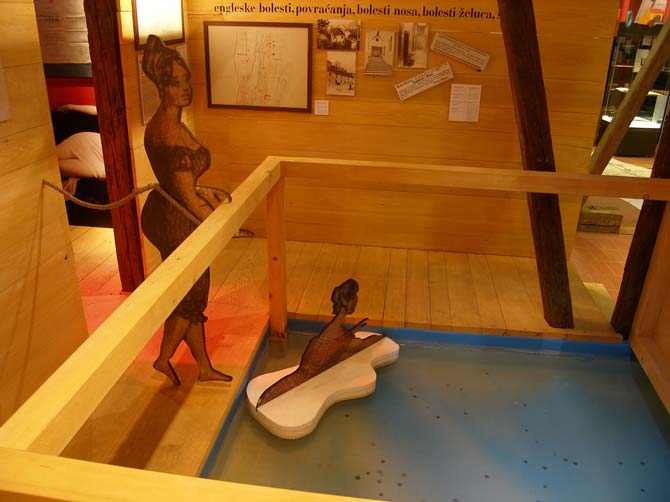
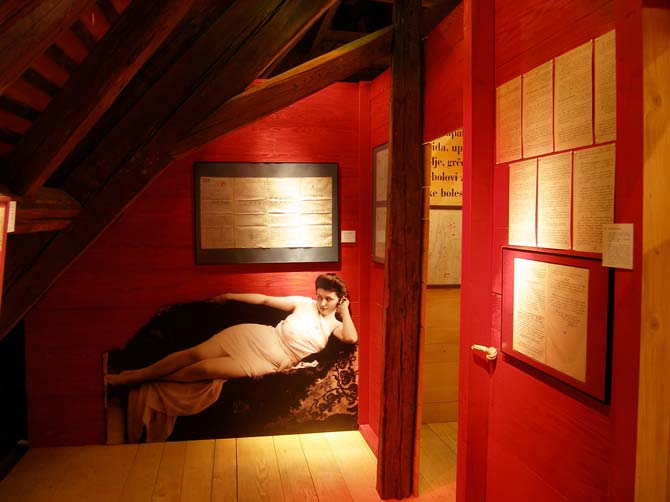


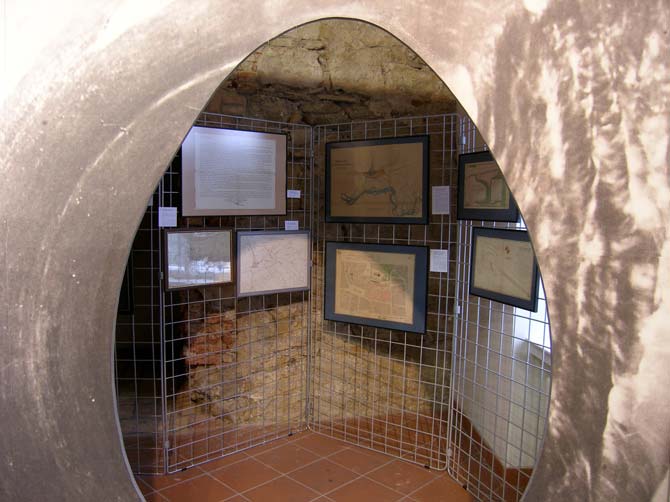

photo Miljenko Gregl, ZCM
 Exhibition catalogue
Exhibition catalogue
Premerl, Nada; Aleksandra Muraj; Goran Arčabić; Ljudevit Tropan; Željko Kovačić. A Brook in the Heart of Zagreb - Along the Medveščak Brook from source to mouth.
Zagreb : Zagreb City Museum, 2005.

